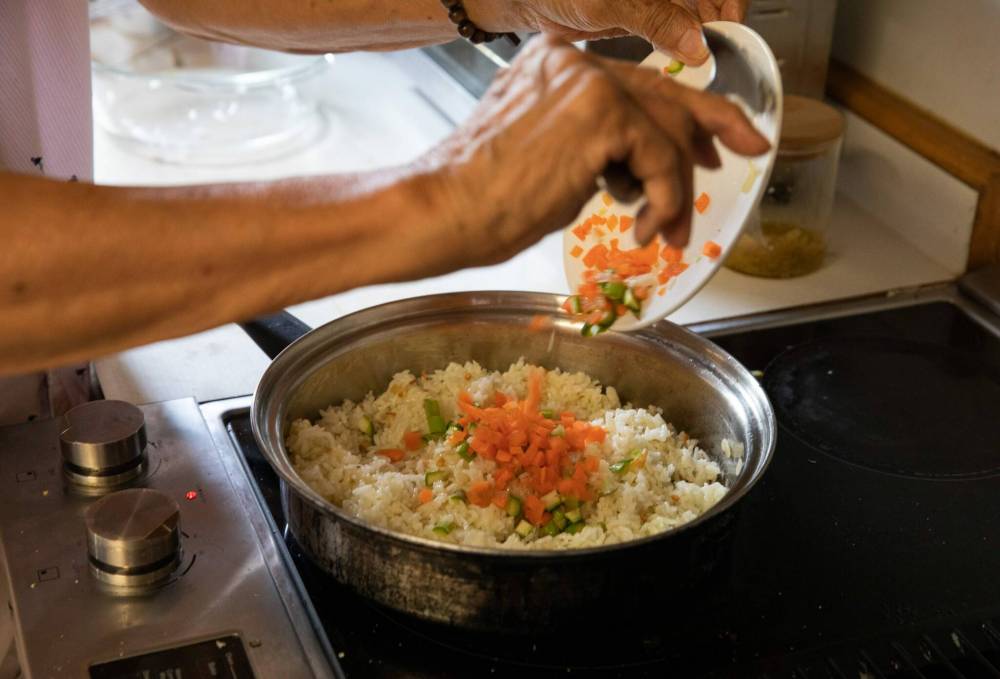Adobo a la abode
For father-son duo, making Filipino staple adobo is a family affair
Advertisement
Read this article for free:
or
Already have an account? Log in here »
To continue reading, please subscribe:
Monthly Digital Subscription
$0 for the first 4 weeks*
- Enjoy unlimited reading on winnipegfreepress.com
- Read the E-Edition, our digital replica newspaper
- Access News Break, our award-winning app
- Play interactive puzzles
*No charge for 4 weeks then price increases to the regular rate of $19.00 plus GST every four weeks. Offer available to new and qualified returning subscribers only. Cancel any time.
Monthly Digital Subscription
$4.75/week*
- Enjoy unlimited reading on winnipegfreepress.com
- Read the E-Edition, our digital replica newspaper
- Access News Break, our award-winning app
- Play interactive puzzles
*Billed as $19 plus GST every four weeks. Cancel any time.
To continue reading, please subscribe:
Add Free Press access to your Brandon Sun subscription for only an additional
$1 for the first 4 weeks*
*Your next subscription payment will increase by $1.00 and you will be charged $16.99 plus GST for four weeks. After four weeks, your payment will increase to $23.99 plus GST every four weeks.
Read unlimited articles for free today:
or
Already have an account? Log in here »
Hey there, time traveller!
This article was published 14/06/2023 (914 days ago), so information in it may no longer be current.
Adobo reigns supreme in the Cantiveros family.
For 81-year-old patriarch Rod, the savoury mixture of slow-cooked pork, soy sauce, vinegar and aromatics takes him right back to the Philippines.
“It’s as if I were at our long table with my seven siblings,” he says, adding that food waste and expense were top-of-mind for his single mother. “You have to be able to manage how to use everything without discarding, so my mom was very, very creative in making some of those Filipino dishes. Adobo is one of those.”
When Rod moved to Winnipeg in 1974, his mother’s adobo recipe helped soften the culinary culture shock he experienced upon arrival. At the time, few local grocery stores stocked ingredients from the Philippines, making it hard to replicate familiar home-cooked dishes. Soy sauce and vinegar, however, were widely available.
JESSICA LEE / WINNIPEG FREE PRESS Rod Cantiveros (left) and his son Ron once ran Hot Rod’s Filipino Grill, a food truck that served longanisa.
“It was a saving grace,” he says.
Adobo has also been a “saving grace” for Rod’s eldest son, Ron Cantiveros, on busy nights when he’s scrambling to make dinner for his own kids.
“It’s easy, it’s quick. I could probably do it in my sleep,” he says.
Growing up, the dish was likewise a dinner staple for Ron and his younger brother. The pair was often in charge of making their own after-school meals while their parents were working multiple jobs and managing the family business, community newspaper the Filipino Journal.
“One time there was a small fire,” Ron says with a laugh. “We burned a few hotdogs and deep-fried eggs along the way.”
JESSICA LEE / WINNIPEG FREE PRESS Rod Cantiveros prepares rice in a pan at his son Ron’s home.
He’s become a more capable cook in adulthood. He even spent a stint building a food business with his dad, in addition to helping run the community newspaper.
Hot Rod’s Filipino Grill grew out of the family’s home-based longanisa operation. Friends encouraged them to take the recipe for their sweet sausage public, and the food cart hit the streets in 2015. Hot Rod’s specialized in Manila-style street food — adobo, unsurprisingly, became a menu staple. The cart was one of the first Filipino “restaurants” in the city.
While the father-son entrepreneurs eventually realized passion doesn’t always make for a viable business, food remains an important part of their relationship.
“Eating as a family right now is a very precious moment,” says Rod, whose wife Linda died in 2008 and whose youngest son, John, now lives in Vancouver. “The stomach is near to the heart; you have to feed them (both) properly.”
They don’t cook together much anymore, but Rod will often make extra portions to drop off at Ron’s house. The elder Cantiveros treats every meal like a special occasion — a full table setting for one with soup, salad, entrée and a “six-ounce glass of wine.” The whole process is a labour of love.
JESSICA LEE / WINNIPEG FREE PRESS Rod Cantiveros likes his adobo with garlic fried rice, mango-tomato salad and buttery mushrooms.
“I love cooking,” Rod says. “And I love dining.”
Although he has no formal culinary training, Rod cooks with precision — stirring, tasting and plating dishes with a flourish.
At the “Pincarrow Inn” (Rod’s nickname for his home kitchen), adobo is served with garlic fried rice, mango and tomato salad, and buttery fried mushrooms.
There are many versions of adobo in the Philippines. The Cantiveroses specialize in a saucy, stew-like dish popular in the northern province of Quezon, where Rod was born.
June is Filipino Heritage Month in Manitoba. For Ron, food is an important ingredient in building community.
JESSICA LEE / WINNIPEG FREE PRESS Pork belly adobo (left) made by Rod Cantiveros, with side dishes
“If you go to a Filipino birthday, christening, wedding, there’s a lot more food than you’d expect,” he says. “Celebrations bring people together and we use food as an opportunity to celebrate.”
For Rod, home cooking offers a visceral connection to his family and birthplace. His long-running column in the Filipino Journal is titled “The Republic of Adobo.”
“You’re eating the nostalgia, you’re smelling the nostalgia and you’re savouring the nostalgia,” he says. “There is a connection with the taste wherever you go. And with the Filipino diaspora, everybody knows how to make adobo — and their own regional version.
“Adobo distinguishes the origin of an individual.”
eva.wasney@winnipegfreepress.com
Twitter: @evawasney
Filipino Pork Belly Adobo
Submitted by Rod and Ron Cantiveros
JESSICA LEE / WINNIPEG FREE PRESS Pork belly adobo is a Filipino fave.
1.4 kg (3 lb) pork belly or pork butt, cut into 1- or 2-inch bite-sized cubes
250 ml (1 cup) dark soy sauce
250 ml (1 cup) cane vinegar
500 ml (2 cups) water
15 ml (1 tbsp) whole peppercorns
5 ml (1 tsp) salt
5 bay leaves
15 ml (1 tbsp) brown sugar
2 medium onions, diced
1 head of garlic, minced (yes, 1 head of garlic)
1 scallion, sliced
1 Thai chili, sliced
Place cubed pork in a bowl. Add soy sauce, vinegar, peppercorn, salt and bay leaves and mix in the marinade. Pork should marinate for at least 30 minutes, or ideally, overnight.
In a lightly oiled pan or skillet, pan sear marinated pork until it’s crispy and browned. Save the liquid marinade.
Set aside pork and, in the same pan with the delicious drippings, add a splash of olive oil and sweat the onions and garlic for two minutes, or until lightly browned.
Return pork cubes back to the pan and add brown sugar, water and remaining liquid marinade. Turn down to low-medium heat and simmer, covered, for 30 to 45 minutes. Cook until pork is tender. Add salt to taste.
Serve adobo on hot rice. Garnish with sliced Thai chili and scallions.
This recipe was originally published in Homemade: Recipes and Stories from Winnipeg and Beyond. Visit Homemade to purchase an e-version of the cookbook.

Eva Wasney has been a reporter with the Free Press Arts & Life department since 2019. Read more about Eva.
Every piece of reporting Eva produces is reviewed by an editing team before it is posted online or published in print — part of the Free Press‘s tradition, since 1872, of producing reliable independent journalism. Read more about Free Press’s history and mandate, and learn how our newsroom operates.
Our newsroom depends on a growing audience of readers to power our journalism. If you are not a paid reader, please consider becoming a subscriber.
Our newsroom depends on its audience of readers to power our journalism. Thank you for your support.





